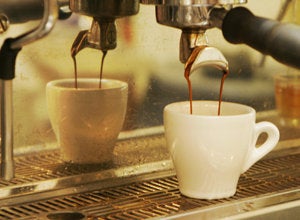
Since moving to New York in 2007, I have been following with somewhat obsessive interest the spread of good coffee across the city. By good coffee I suppose I mainly mean good espresso, made on a manual machine by people who care. Naturally, this rules out Starbucks, whose turn toward mediocrity became clear with the switch to automatic espresso machines in the early 2000s. I had worked at a Starbucks briefly in 2001, when the company still used high-quality manual machines made by La Marzocco, and was dismayed by this change, which seemed to convey the company's lack of faith in its baristas to do anything subtler than press buttons. Of course, the result was distinctly inferior coffee. Howard Schultz, the Starbucks CEO generally described these days as "embattled," appears keen to reverse this trend--which is nice, since he was responsible for it in the first place. I hope he succeeds, as finding a good cappuccino would then be as simple as finding a Senegalese umbrella-peddler in a rainstorm.
But for now, finding the good stuff can still require a little effort. This is especially true if you live in the outer reaches of caffeinated civilization: for example, the far east 80s, where I live. Here on the Upper East Side, we inhabit a virtual coffee desert, the only oases being the expensive and table-service-only (but great) Café Sabarsky at the Neue Galerie, and the expensive and self-satisfied (but at least very Italian) Sant'Ambroeus and Via Quadronno, both in the east 70s.
To the true coffee lover, however, distance is no barrier. For a long time it was enough for me to hear of a good place in some wildly inconvenient neighborhood, and I'd be there. Balzac was apparently the same way, traveling from one corner of Paris to another to get his coffee beans--Mocha Java in this arrondissement, Bourbon (the coffee varietal, not the spirit) in that; he spent hours on these errands. I first got to know certain New York streets and neighborhoods from my espresso-scouting missions: West 20th Street, for example (Café Grumpy), or Alphabet City (the immortal Ninth Street Espresso). A mental map started to emerge, illuminated as if by a caffeinated glow in each of these spots.
Many of the places tended to be downtown. Good espresso bars, like good restaurants, have in recent years congregated below 14th Street, that frontier which seems to separate the hip from the humdrum. The reasons for this clustering effect are fairly clear: downtown one finds more young people, more students, more artists--in short, more people with hours during the day when they don't have to be somewhere. A place like Doma on Perry Street can get so crowded on, say, a Wednesday morning at 11, that one simply can't find a seat. The same goes for places with superior coffee, such as Ninth Street Espresso, or Joe: The Art of Coffee, in its original Waverly Place location, or Jack's Stir-Brew Coffee, around the corner from Joe, on West 10th Street.
There are those from even more caffeinated societies than this one--the Pacific Northwest, or Italy for that matter--who might say New York still has a ways to go in terms of espresso-bar saturation. But it has been cheering to see good coffee make its way up Manhattan island, even in the relatively short time I've lived here. The excellent Joe, run by Jonathan Rubinstein, expanded to Chelsea, then Grand Central (an original and savvy choice), then the Upper West Side, keeping to its high standards in each. There was also the exciting arrival of Stumptown, the outstanding Portland, OR, roaster, in a beautifully appointed space at the Ace Hotel on 29th Street. Perhaps slightly less exalted, but still excellent alternatives to Starbucks, are the midtown espresso bars Zibetto and Fika, and the quality Israeli chain Aroma, on the Upper West Side (there is also a Soho branch). I could go on.
In short, New York, which seldom contents itself with being second-best, has entered a golden period for coffee, one which keeps getting better. Indeed, it seems my own neighborhood, the Upper East Side, may be the only place not getting its fix of good espresso. Is café society doomed to fail in this neighborhood of busy bankers and Pilates-hardened wives? Well, I will continue to take the subway to wherever I need to go for the one true beverage. But would it be too much to hope that some espresso entrepreneur will take pity on our neighborhood in 2010? There might just be a line around the block.